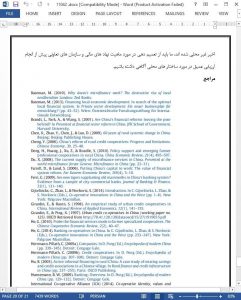Abstract
In recent decades the Chinese financial system has undergone dramatic restructuring, which has substantially altered the country's mutual and co-operative financial institutions. This paper aims to contribute to our understanding of the process, practice and consequences of these developments by systematically charting the trajectory and dynamics of the co-operative financial landscape in China, and by analysing the role that these financial institutions have played in China's socioeconomic change. It is argued that China's financial co-operatives have been de-localised through processes of consolidation and centralisation. They have also been increasingly commercialised within a system based on ‘market logic’, which has changed their developmental role in the Chinese economy. At the same time, however, recent policy has sought to reinstitute locally-focused financial and farmer co-operatives in rural areas. Moreover, local informal and semi-formal modes of co-operative organisation and action have continued to be widespread across the country.
1. Introduction
Since the start of the market reforms in the late 1970s, China has witnessed rapid and sustained economic growth1 accompanied by substantially diversified livelihoods in both urban and rural areas. The transformations taking place in the Chinese economy and society during the recent decades cannot be separated from the dramatic change in the country’s financial system. This financial restructuring has resulted in a considerably diversified and expanded financial sector consisting of extensive national networks of both formal and informal financial service providers whose reach extend from urban to rural areas, and from coastal to more remote inland regions. Owned largely by the central or local state, the formal financial institutions have played an active and pivotal role in channelling resources to indigenous industries, including township and village enterprises (TVEs),2 that have driven the country’s rapid industrialisation (Bateman, 2010; Oi, 1999). One of the key elements of the shifting financial and developmental landscapes has been co-operative financing, represented in particular by the urban and rural credit co-operatives, and rural co-operative foundations. These co-operatives were founded at different points in time and were often based on egalitarian principles of mutuality, co-operation, community solidarity and cohesion, and provided a means of protecting their members from usurious loan sharks while at the same time promoting local development (Cheng, 2006).
6. Conclusion
This paper has systematically charted the trajectory, dynamics and the changing landscape of co-operative finance in China, and analysed the role that co-operative financial institutions and organisations have played in China’s socioeconomic change more broadly. What has emerged is a picture of complex and dynamic institutional change, which has resulted in diverse outcomes for the development and operation of co-operative financial service providers in the country. For instance, rural credit co-operatives, which were established in the 1940s as a response to usurious lending practices, were quickly integrated into a nationwide network and have become the backbone of the rural financial system accounting for 80% of savings and loans in rural areas (Ong, 2011). Rural co-operative foundations and urban credit cooperatives, on the other hand, sprung up across the country after the market reforms beginning in 1978, as independent locally run institutions. In the first two decades after the market reforms all three of these institutions played a major role in China’s economic ‘miracle’ by supporting local industrialisation before being consolidated, transformed into commercial banks, or shutdown in the late 1990s. Finally, informal and semi-formal financial organisations exhibiting at least some co-operative characteristics, such as rotating savings and credit associations and specialised farmer co-operatives, have expanded and diversified, and have been increasingly brought into formal legal structures in recent decades.










